Language/Sundanese/Vocabulary/Fruits
Hi Sundanese learners! 😊
In this lesson, we will learn about the delicious fruits in Sundanese! Fruits are an essential part of the Sundanese diet, not only because they are healthy but also because they are enjoyed for their sweet and sour taste. We will provide their Sundanese names with their respective pronunciations and English translations. We've also included some cultural information and interesting facts to make the learning experience more enjoyable!
Once you've mastered this lesson, take a look at these related pages: Express Surprise & Colors.
Indonesian vs Sundanese Fruits[edit | edit source]
As Sundanese is a subset of the Indonesian language, some of the fruit names are the same in both languages. Here are some commonly known fruits in Indonesia along with their Sundanese translations:
| Indonesian | Sundanese | English |
|---|---|---|
| Jeruk | Citra/Buah agrum | Orange/citrus |
| Nangka | Nimah | Jackfruit |
| Mangga | Muhun | Mango |
| Pisang | Gedhang | Banana |
| Anggur | Winna | Grapes |
| Rambutan | Siputih/Gonjing | Rambutan |
| Jambu biji | Jambuh | Guava |
Sundanese Fruits[edit | edit source]
Now, let's learn about the fruits that are only known in Sundanese:
Oyong[edit | edit source]
Oyong (pronounced oh-yong) is also known as snake gourd in English. It is a popular fruit in Sundanese cuisine known for its slightly sweet and bitter taste. Oyong is a climbing plant that grows on a trellis or other support.
| Sundanese | Pronunciation | English |
|---|---|---|
| Oyong | oh-yong | Snake gourd |
Dialogues:
- Person 1: Mangga kuring manis banget! (My mango is very sweet!)
- Person 2: Mangga kuring ogok. Gedhena manis tapi kantosna lagit pait. (My mango is unripe. It will be sweet but it's still a bit sour.)
Kaca beling[edit | edit source]
Kaca beling (pronounced ka-cha bell-ing) is a very rare fruit that is only found in West Java (Jawa Barat). It is so named because it is transparent like a glass window, and has a crunchy texture. Kaca beling is shaped like a pear and is usually eaten raw or used as a sweetener.
| Sundanese | Pronunciation | English |
|---|---|---|
| Kaca beling | ka-cha bell-ing | Glass fruit |
Dialogues:
- Person 1: Kaca beling leuwih legi dibanding buah sejen. (Kaca beling is rarer than other fruits.)
- Person 2: Tapi rasa nya endah benar. (But its taste is truly delightful!)
Lengkeng[edit | edit source]
Lengkeng (pronounced leng-keng) is also known as longan in English. It is a small and oval-shaped fruit with a brown skin that is hard and brittle. The fruit is soft and juicy and contains a hard seed. Lengkeng is a popular fruit in Sundanese culture and is believed to have many health benefits.
| Sundanese | Pronunciation | English |
|---|---|---|
| Lengkeng | leng-keng | Longan |
Dialogues:
- Person 1: Lengkeng nya dikira mata bohong kuring. (I thought the longans were lying eyes.)
- Person 2: Haha, engke deui, henteu geura bisa ka bohong. (Haha, no, they're not lying, they're real and delicious!)
Sawo[edit | edit source]
Sawo (pronounced sah-woh), also known as Sapodilla, is a fruit that is native to Central America and the Caribbean. The fruit has a brown, rough exterior and a sweet, juicy flesh. Sawo is popular in Sundanese culture as its sap is used in making natural gum.
| Sundanese | Pronunciation | English |
|---|---|---|
| Sawo | sah-woh | Sapodilla |
Dialogues:
- Person 1: Emang teh sawo naon bedana jeung ciku? (What's the difference between sawo and ciku?)
- Person 2: Naon teh, jalma biasana lawan bedana ari sapana. (Well, people mostly differentiate them based on their taste.)
Conclusion[edit | edit source]
In Sundanese culture, fruits are not just meant to be enjoyed for their taste but also as a symbol of appreciation for nature's blessing. We hope this lesson helped you with your Sundanese vocabulary! Don't forget to practice with natives using this interactive platform on Polyglot Club. Also, check out more Sundanese vocabulary!
➡ If you have any questions, please ask them in the comments section below.
➡ Feel free to edit this wiki page if you think it can be improved. 😎
Sources[edit | edit source]
- Sundanese Vocabulary - Fruits
- Fruit names in Sundanese & English | Fruits in Sundanese - Learn ...
- Learn Sundanese language online with games and flashcards
With this lesson finished, you may want to explore these additional pages: Health & Drinks.

